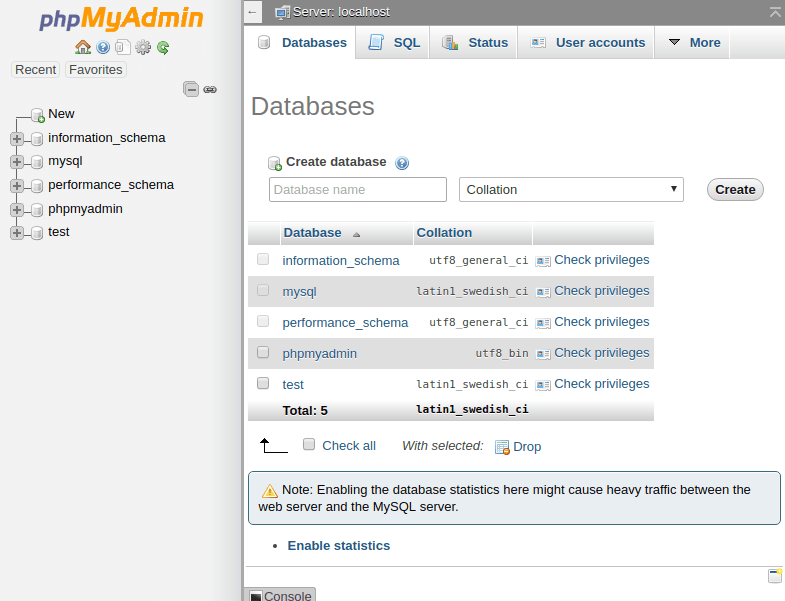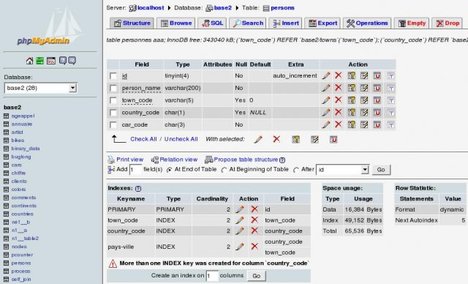

- LAUNCH PHPMYADMIN UBUNTU HOW TO
- LAUNCH PHPMYADMIN UBUNTU INSTALL
- LAUNCH PHPMYADMIN UBUNTU FULL
- LAUNCH PHPMYADMIN UBUNTU PASSWORD
- LAUNCH PHPMYADMIN UBUNTU FREE
htaccess file in the phpMyAdmin application directory using the following command: sudo nano /usr/share/phpmyadmin/.htaccess Restart the Apache web server to implement the changes by using this command: sudo systemctl restart apache2 Save and exit the file by pressing CTRL+X.

It shows the number of connections to the MySQL database server, current MySQL queries running on the server, and how long the server has been operating. We recommend looking at the Status tab on the phpMyAdmin dashboard. This is the command to do so: sudo systemctl restart apache2 Restart the Apache server if you encounter any problems logging in.
LAUNCH PHPMYADMIN UBUNTU PASSWORD
Remember to use a strong password to secure the account. Replace username and password with the desired MySQL credentials. GRANT ALL PRIVILEGES ON *.* TO PRIVILEGES Then, enter the following commands to create a new user: CREATE USER username IDENTIFIED by 'password' Input the MySQL root password when prompted.

Use this command to do so: sudo mysql -u root -p You have to access the MySQL command-line interface as a root user to create a dedicated user.
LAUNCH PHPMYADMIN UBUNTU FULL
If you don’t want to use or work with phpMyAdmin’s default user account for security reasons, create a new dedicated MySQL user with full privileges. Create a Separate phpMyAdmin User (Optional) After that, you will be taken to the phpMyAdmin web interface. Instead, log in with the phpmyadmin username and the MySQL password you set during Step 1. If you’re using Hostinger VPS, you will find the IP address on the server management panel.ĭue to security issues, Ubuntu 18.04 and Ubuntu 20.04 don’t support root login. When the installation procedure is complete, open the browser and go to Replace your-server-IP with the server’s IP address. Once you’ve accessed the MySQL root account, grant permissions to the phpmyadmin by executing these commands one at a time: GRANT ALL PRIVILEGES ON *.* TO PRIVILEGES ĮXIT Step 3. You’ll have to enter the MySQL root password before accessing the command line. To manage MySQL users, log in to the MySQL command line as a root user with this command: sudo mysql -u root -p You’ll have to grant some permissions to phpMyAdmin to make it a practical solution to create and manage MySQL databases. The default phpMyAdmin account has minimal options available. Once completed, enable the PHP Mbstring extension with this command: sudo phpenmod mbstringįinally, restart the Apache service by using this command: sudo systemctl restart apache2 Step 2. Select Yes and set a strong and unique password for phpMyAdmin. Pick Apache2 by pressing the Space key and hit Enter to continue.Ĭonfiguring the database follows the same process. Then, you will need to select a web server.

LAUNCH PHPMYADMIN UBUNTU INSTALL
However, you’ll have to run this command instead: sudo apt install phpmyadmin php-mbstring php-zip php-gd php-json php-curl The steps to install phpMyAdmin on Ubuntu 20.04 are quite similar. A * character will appear in the bracket next to apache2, indicating that you’ve selected it. Run the following command to install the phpMyAdmin package and required PHP extensions: sudo apt-get install -y phpmyadmin php-mbstring php-gettextĭuring the installation process, you will have to select a web server to configure phpMyAdmin. However, there are some command differences between Ubuntu 18.04 and Ubuntu 20.04. The installation procedure is relatively easy using an SSH client. In addition to the installation, you’ll need to grant permissions, create a separate user, and secure phpMyAdmin. Installing phpMyAdmin on Ubuntu involves five steps.
LAUNCH PHPMYADMIN UBUNTU HOW TO
How to Install phpMyAdmin – Ubuntu 18.04 and 20.04 We have a tutorial on how to connect PuTTY to the server if you have trouble with it. You’ll also need to use an SSH client to connect to the server. Also, the MySQL database should be up and running. This article will walk you through the process of phpMyAdmin installation on Ubuntu servers versions 18.04 and 20.04.ĭownload Complete Linux Commands Cheat Sheet Before Installing phpMyAdminīefore you begin, you’ll need to install the LAMP (Linux, Apache, MySQL, PHP) stack on your server. If you’re using a virtual private server, you’ll have to install phpMyAdmin on the server manually. Even though it isn’t technically necessary as you can manage the databases using the command line interface, phpMyAdmin is more user-friendly.
LAUNCH PHPMYADMIN UBUNTU FREE
PhpMyAdmin is a free and open-source Graphical User Interface (GUI) tool used to manage MySQL databases on shared and VPS hosting plans.


 0 kommentar(er)
0 kommentar(er)
